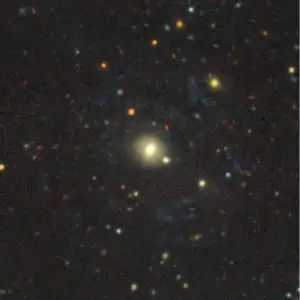Malin 1
Malin 1 is a giant low surface brightness (LSB) spiral galaxy.[1][5] It is located 1.19 billion light-years (366 Mpc) away in the constellation Coma Berenices, near the North Galactic Pole. As of February 2015, it is the largest known spiral galaxy, with an approximate diameter of 650,000 light-years (200,000 pc),[6][7][8] thus over six times the diameter of our Milky Way. It was discovered by astronomer David Malin in 1986 and is the first LSB galaxy verified to exist.[5][8][6] Its high surface brightness central spiral is 30,000 light-years (9,200 pc) across, with a bulge of 10,000 light-years (3,100 pc).[6] The central spiral is a SB0a type barred-spiral.[6]
| Malin 1 | |
|---|---|
 Image by the DESI Legacy Imaging Surveys, Data Release 10 | |
| Observation data (J2000.0[1] epoch) | |
| Constellation | Coma Berenices [2] |
| Right ascension | 12h 36m 59.34697s [1] |
| Declination | +14° 19′ 49.1585″ [1] |
| Redshift | 0.082702±0.000013 [3] |
| Heliocentric radial velocity | 24750±10 km/s [3] |
| Galactocentric velocity | 24707±10 km/s [3] |
| Apparent magnitude (V) | 15.809±0.009[3] |
| Absolute magnitude (V) | −22.01±0.50[3] |
| Characteristics | |
| Type | SB0a [1] |
| Mass | ~1012[4] M☉ |
| Size | 34.11 to 36.39 kpc (111,250 to 118,690 ly) (diameter; D25.0 B-band and 2MASS K-band total isophotes)[3][lower-alpha 1] |
| Apparent size (V) | 0.25′ × 0.23′[3] |
| Notable features | Surrounded by a H I disk |
| Other designations | |
| PGC 42102, LEDA 42102, VPC 1091, 2MASX J12365934+1419494, Gaia DR2 3932516418935413504[1] | |
Malin 1 is peculiar in several ways: its diameter alone would make it the largest barred spiral galaxy ever to have been observed.[4]
Malin 1 was found later to be interacting with two other galaxies, Malin 1B and SDSS J123708.91+142253.2. Malin 1B is located 46,000 light-years (14,000 pc) away from the high surface brightness central spiral of Malin 1, which may be responsible for the formation of the galaxy's central bar. Meanwhile, SDSS J123708.91+142253.2 is located within the huge, faint halo of Malin 1 and might have caused the formation of the extended low surface brightness disc through tidal stripping.
Observations by Galaz et al. in April 2014 revealed a detailed view of the spiral structure of Malin 1 in optical bands. The galaxy exhibits giant and very faint spiral arms, with some segments up to 33,000 light-years (10,000 pc) in diameter. Other details, such as possible stellar streams and formation regions, are revealed as well.[9] The same authors also say that Malin 1 is larger than thought, with another estimated diameter of around 750,000 light-years (230,000 pc).[9]
Gallery
.jpg.webp) Processed image of Malin 1 by Giuseppe Donatiello showing its weak spiral arms.
Processed image of Malin 1 by Giuseppe Donatiello showing its weak spiral arms..jpg.webp) Malin 1 imaged in grayscale by the Hubble Space Telescope.
Malin 1 imaged in grayscale by the Hubble Space Telescope.
See also
- NGC 6872, large interacting barred spiral galaxy claimed in 2013 as largest spiral galaxy
- NGC 262, lenticular galaxy surrounded by a huge H I cloud discovered in 1885
- UGC 2885, a large unbarred spiral galaxy
Notes
References
- "2MASX J12365934+1419494". SIMBAD. Centre de données astronomiques de Strasbourg. Retrieved 27 October 2010.
- "PGC 42102". WikiSky. Archived from the original on 7 March 2019. Retrieved 27 October 2010.
- "Detailed Information for Object Malin 1". NASA/IPAC Extragalactic Database. Retrieved April 18, 2012.
- Barth, Aaron J. (March 2007). "A Normal Stellar Disk in the Galaxy Malin 1". The Astronomical Journal. 133 (3): 1085–1091. arXiv:astro-ph/0701018. Bibcode:2007AJ....133.1085B. doi:10.1086/511180. S2CID 14631639.
- Bothun, Gregory D. (February 1997). "The Ghostliest Galaxies". Scientific American. 276 (2): 56–61. Bibcode:1997SciAm.276b..40B. doi:10.1038/scientificamerican0297-56. JSTOR 24993608.
- Crosswell, Ken (22 January 2007). "Malin 1: A Bizarre Galaxy Gets Slightly Less So". KenCroswell.com.
- Dorminey, Bruce (22 December 2013). "Astronomers Still Puzzle Over 'Low Surface Brightness' Galaxies". Forbes. Retrieved 30 December 2014.
- Glenday, Craig, ed. (2011). Guinness World Records 2011. New York: Random House. p. 3. ISBN 978-0-440-42310-2.
- Galaz, Gaspar; et al. (December 2015). "Deep Optical Images of Malin 1 Reveal New Features". The Astrophysical Journal Letters. 815 (2). L29. arXiv:1512.01095. Bibcode:2015ApJ...815L..29G. doi:10.1088/2041-8205/815/2/L29. S2CID 31114340.
External links
 Media related to Malin 1 at Wikimedia Commons
Media related to Malin 1 at Wikimedia Commons